1993 CHEVROLET ASTRO PASSENGER light
[x] Cancel search: lightPage 178 of 345
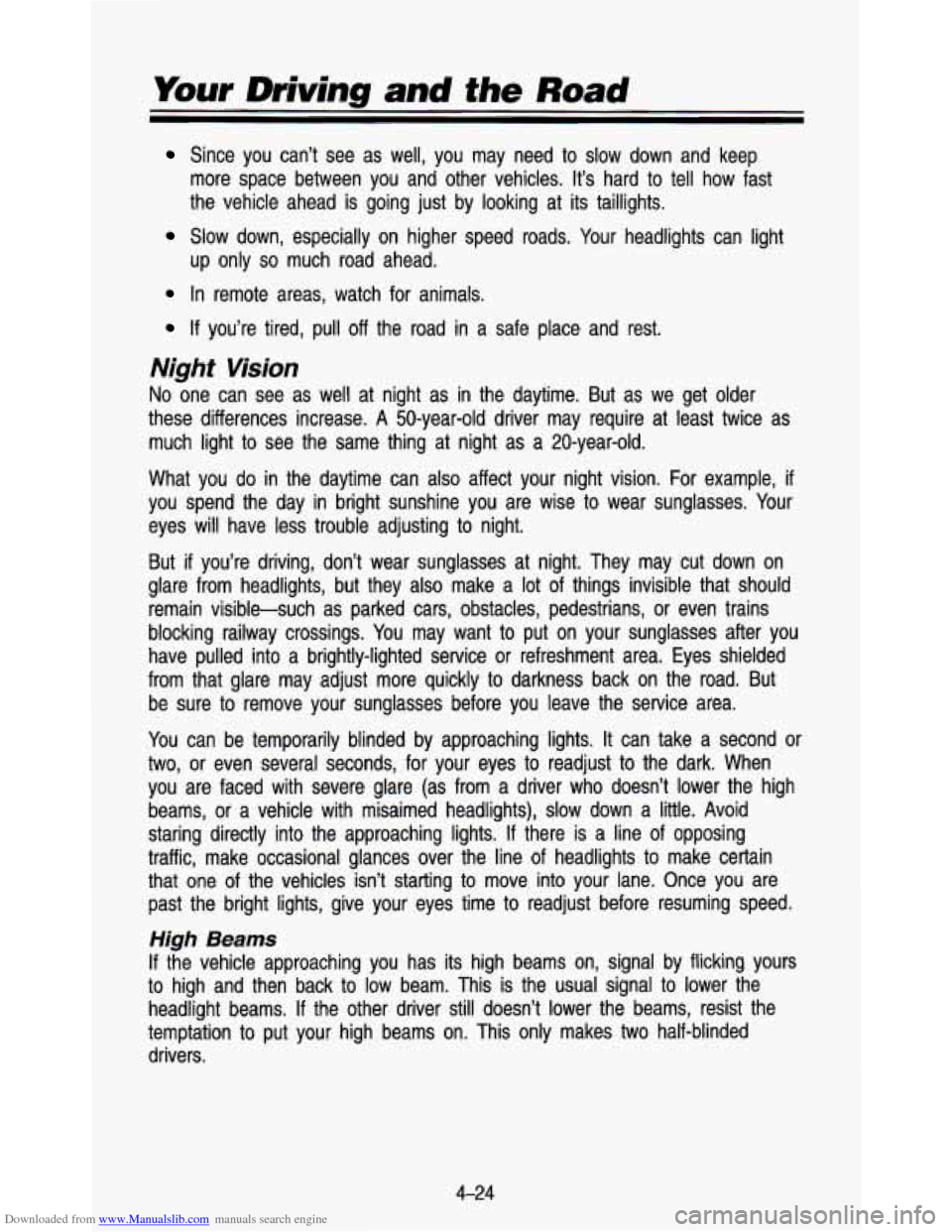
Downloaded from www.Manualslib.com manuals search engine Your Driving and the Road
Since you can’t see as well, you may need to slow down an\
d keep more space between you and other vehicles. It’s hard to tel\
l how fast
the vehicle ahead is going just by looking at its taillights. \
Slow down, especially on higher speed roads. Your headlights can light
up only
so much road ahead.
In remote areas, watch for animals.
If you’re tired, pull off the road in a safe place and rest.
Night Vision
No one can see as well at night as in the daytime. But as we \
get older
these differences increase.
A 50-year-old driver may require at least twice as
much light to see the same thing at night as a 20-year-old.
What you
do in the daytime can also affect your night vision. For example, if
you spend the day in bright sunshine you are wise to wear su\
nglasses. Your
eyes will have less trouble adjusting to night.
But
if you’re driving, don’t wear sunglasses at night. They may \
cut down on
glare from headlights, but they also make a lot of things inv\
isible that should remain visible-such as parked cars, obstacles, pedestrians,
or even trains
blocking railway crossings. You may want to put on your sunglasses after you
have pulled into a brightly-lighted service
or refreshment area. Eyes shielded
from that glare may adjust more quickly to darkness back on t\
he road. But be sure to remove your sunglasses before you leave the service area.
You can be temporarily blinded by approaching lights. It can take a second
or
two, or even several seconds, for your eyes to readjust to the dark. When
you are faced with severe glare (as from a driver who doesn’\
t lower the high beams,
or a vehicle with misaimed headlights), slow down a little. Avoid\
staring directly into the approaching lights.
If there is a line of opposing
traffic, make occasional glances over the line
of headlights to make certain
that one of the vehicles isn’t starting to move into your \
lane. Once you are past the bright lights, give your eyes time to readjust before resuming speed.
High Beams
If the vehicle approaching you has its high beams on, signal by \
flicking yours
to high and then back to low beam. This is the usual signal \
to lower the
headlight beams.
If the other driver still doesn’t lower the beams, resist the
temptation to put your high beams on. This only makes
two half-blinded
drivers.
4-24
Page 179 of 345
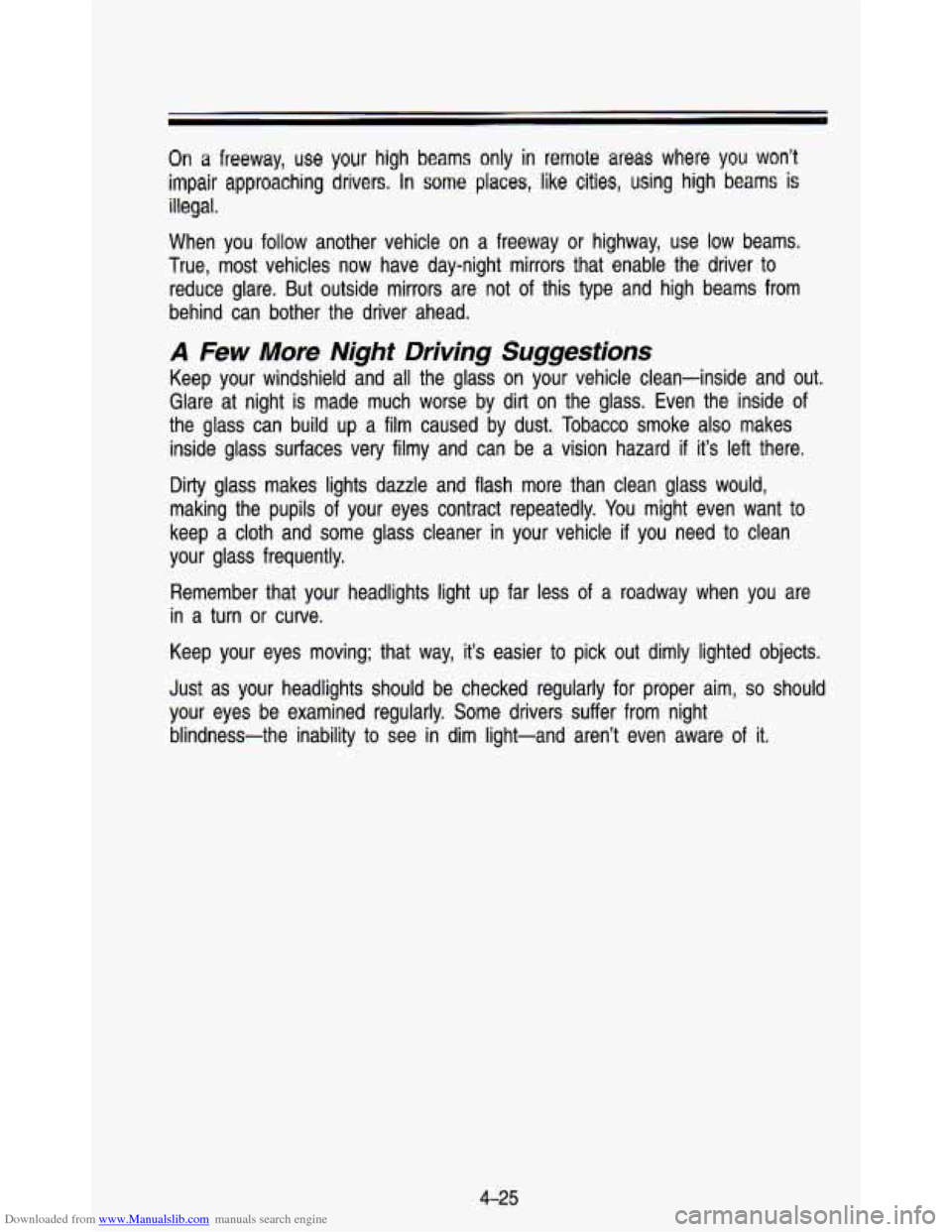
Downloaded from www.Manualslib.com manuals search engine On a freeway, use your high beams only in remote areas where you won’t
impair approaching drivers, In some places, like cities, using high beams is
illegal.
When you follow another vehicle on a freeway or highway, use
low beams.
True, most vehicles now have day-night mirrors that enable the \
driver to reduce glare. But outside mirrors are not of this type and hi\
gh beams from
behind can bother the driver ahead.
A Few More Night Driving Suggestions
Keep your windshield and all the glass on your vehicle clean-i\
nside and out.
Glare at night is made much worse by dirt on the glass. Even the inside
of
the glass can build up a film caused by dust. Tobacco smoke also makes
inside glass surfaces very filmy and can be a vision hazard
if it’s left there.
Dirty glass makes lights dazzle and flash more than clean glas\
s would,
making the pupils
of your eyes contract repeatedly. You might even want to
keep a cloth and some glass cleaner in your vehicle if you need to clean
your glass frequently.
Remember that your headlights light up far less of a roadway when you are
in a turn or curve.
Keep your eyes moving; that way, it’s easier to pick out dimly lighted objects.
Just as your headlights should be checked regularly for proper \
aim,
so should
your eyes be examined regularly. Some drivers suffer from night\
blindness-the inability to see in dim light-and aren’t even aware of it.
4-25
Page 181 of 345
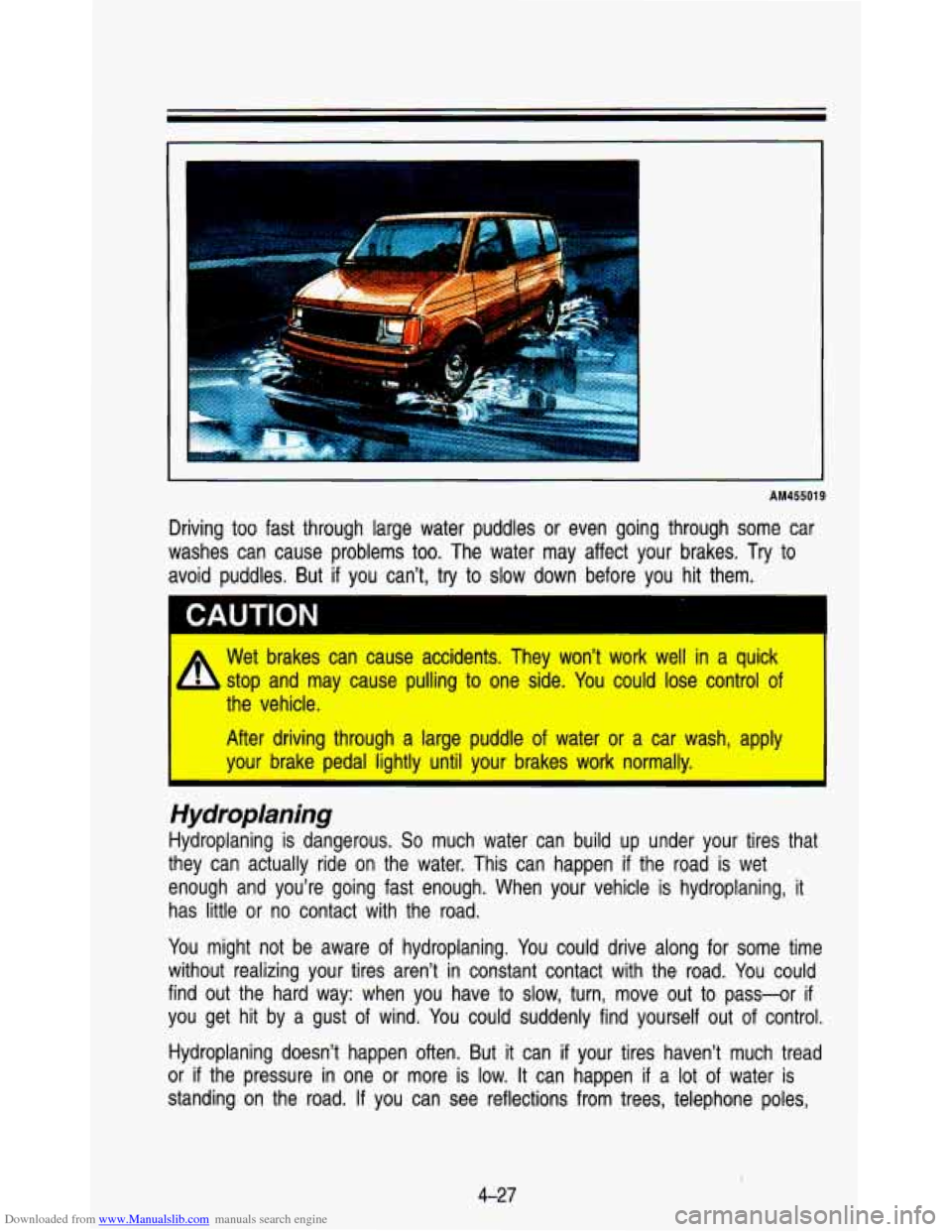
Downloaded from www.Manualslib.com manuals search engine I
AM455019
Driving too fast through large water puddles or even going thr\
ough some car
washes can cause problems
too. The water may affect your brakes. Try to
avoid puddles. But if you can’t, try to slow down before you hit them.
Wet brakes can cause accidents. They won’t work well in a quick
stop and may cause pulling
to one side. You could lose control of
the vehicle.
After driving through a large puddle of water or a car wash, apply
your brake pedal lightly until your brakes work normally.
I
’
I
I
Hydropraning
Hydroplaning is dangerous. So much water can build up under your tires that
they can actually ride on the water. This can happen
if the road is wet
enough and you’re going fast enough. When your vehicle is hydroplaning, it
has
little or no contact with the road.
You might not be aware of hydroplaning. You could drive along for some time
without realizing your tires aren’t in constant contact with the road. You could
find out the hard way: when you have
to slow, turn, move out to pass-or if
you get hit by a gust of wind. You could suddenly find yourself out of control.
Hydroplaning doesn’t happen often. But
it can if your tires haven’t much tread
or
if the pressure in one or more is low. It can happen if a lot of water is
standing on the road. If you can see reflections from trees, \
telephone poles,
4-27
Page 182 of 345
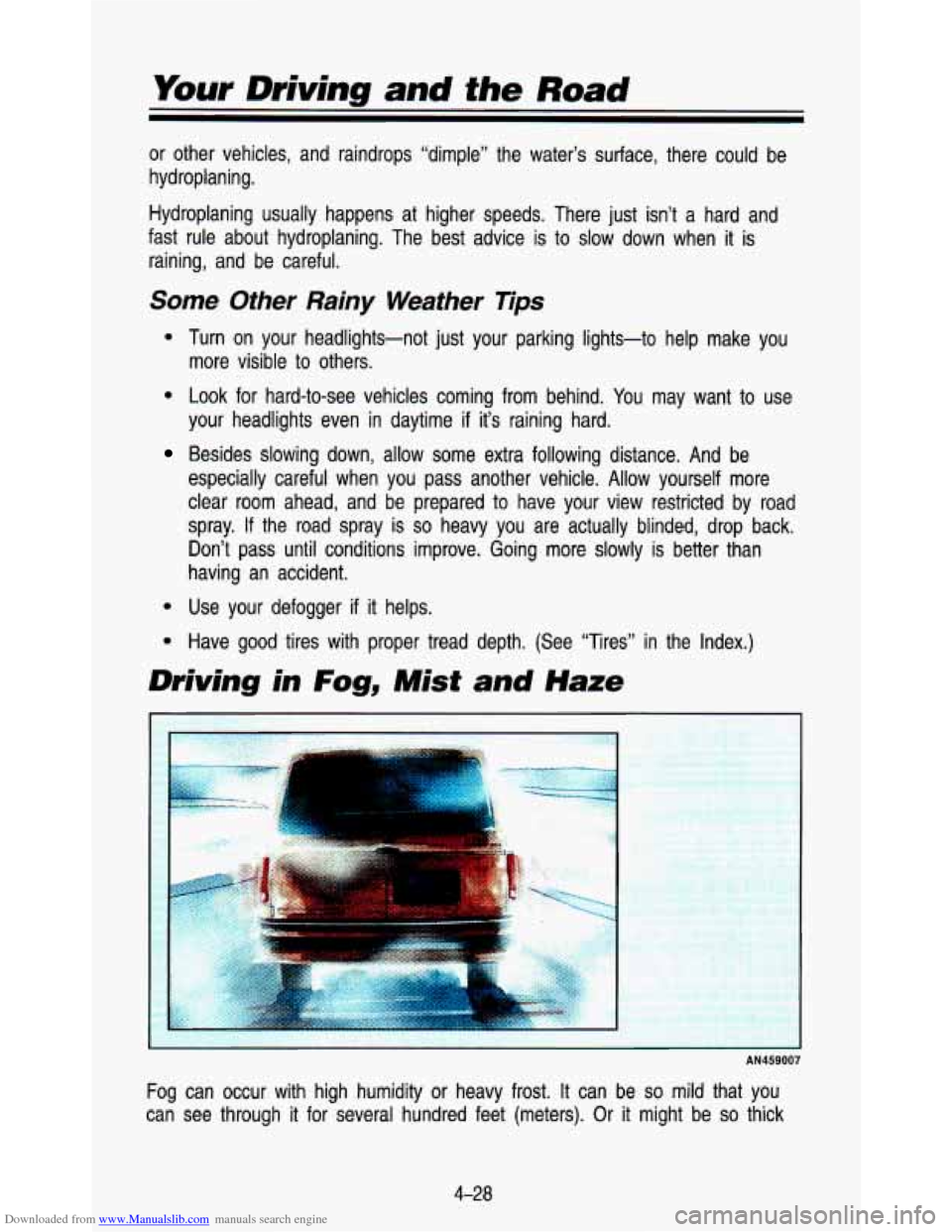
Downloaded from www.Manualslib.com manuals search engine Your Driving and the Road
or other vehicles, and raindrops “dimple” the water’s s\
urface, there could be
hydroplaning. Hydroplaning usually happens at higher speeds. There just isn’\
t a hard and
fast rule about hydroplaning. The best advice
is to slow down when it is
raining, and be careful.
Some Other Rainy Weather Tips
Turn on your headlights-not just your parking lights-to help ma\
ke you more visible
to others.
Look for hard-to-see vehicles coming from behind. You may want to use
your headlights even
in daytime if it’s raining hard.
Besides slowing down, allow some extra following distance. And \
be
especially careful when you pass another vehicle. Allow yourself\
more
clear room ahead, and be prepared
to have your view restricted by road
spray.
If the road spray is so heavy you are actually blinded, drop back.
Don’t pass until conditions improve. Going more slowly is be\
tter than
having an accident.
Use your defogger
if it helps.
Have good tires with proper tread depth. (See “Tires” in\
the Index.)
Driving in Fog, Mist and Haze
I ~
AN459007
Fog can occur with high humidity or heavy frost. It can be so mild that you
can see through
it for several hundred feet (meters). Or it might be so thick
4-28
Page 183 of 345
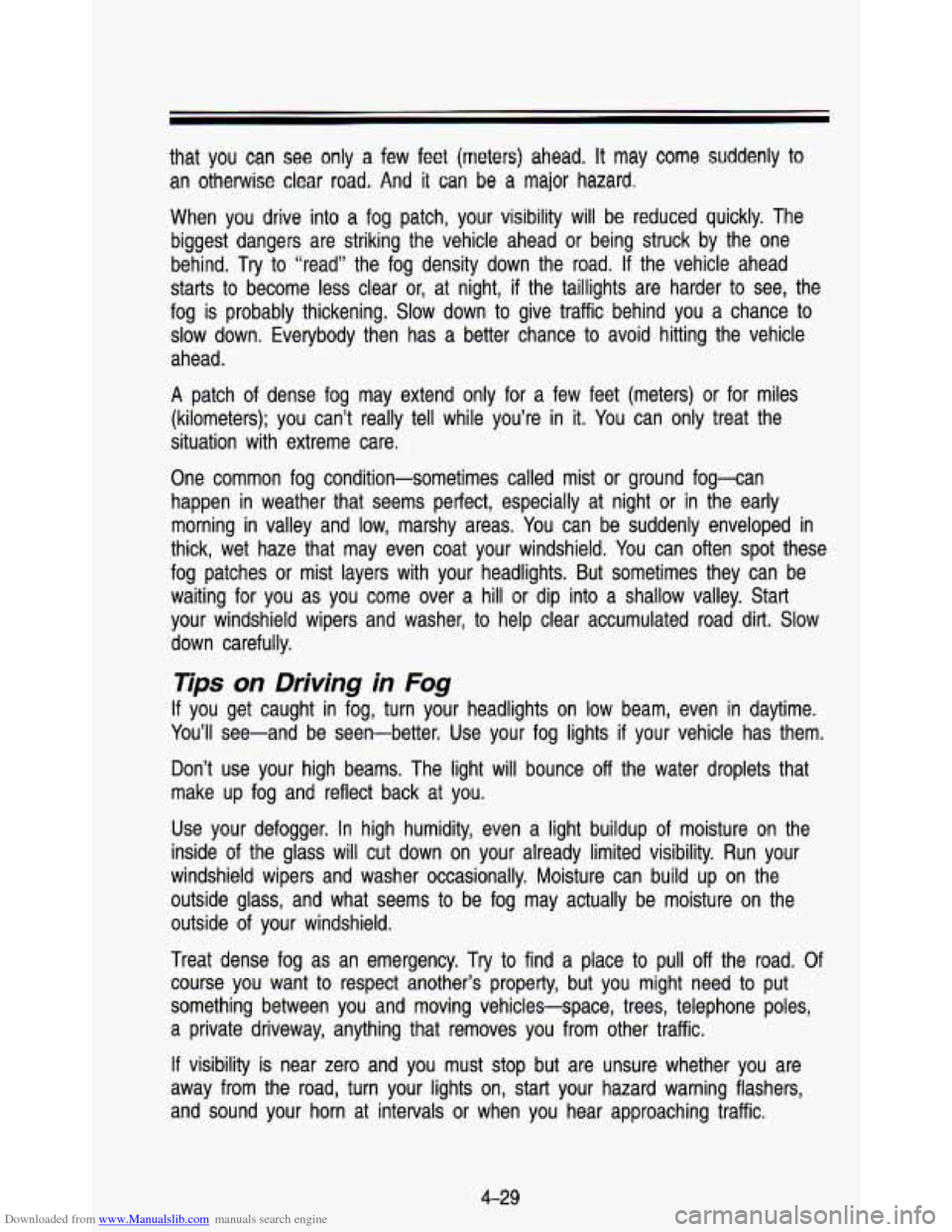
Downloaded from www.Manualslib.com manuals search engine that you can see only a few feet (meters) ahead. It may come suddenly to
an otherwise clear road. And it can be a major hazard.
When you drive into a fog patch, your visibility will be ieduced quickly. The
biggest dangers are striking the vehicle ahead
or being struck by the one
behind. Try
to “read” the fog density down the road. If the vehicle ahead
starts
to become less clear or, at night, if the taillights are harder to see, the
fog is probably thickening. Slow down to give traffic behind y\
ou a chance
to
slow down. Everybody then has a better chance to avoid hitting the vehicle
ahead.
A patch of dense fog may extend only for a few feet (meters) or for miles
(kilometers); you can’t really tell while you’re in
it. You can only treat the
situation with extreme care.
One common fog condition-sometimes called mist
or ground fog-can
happen in weather that seems perfect, especially at night
or in the early
morning in valley and low, marshy areas. You can be suddenly enveloped in
thick, wet haze that may even coat your windshield. You can often spot these
fog patches
or mist layers with your headlights. But sometimes they can be
waiting for you as you come over a hill
or dip into a shallow valley. Start
your windshield wipers and washer,
to help clear accumulated road dirt. Slow
down carefully.
Tips on Driving in Fog
If you get caught in fog, turn your headlights on low beam, even\
in daytime.
You’ll see-and be seen-better. Use your fog lights
if your vehicle has them.
Don’t use your high beams. The light will bounce
off the water droplets that
make up fog and reflect back at you.
Use your defogger. In high humidity, even a light buildup of moisture on the
inside
of the glass will cut down on your already limited visibility. Ru\
n your
windshield wipers and washer occasionally. Moisture can build up\
on the outside glass, and what seems to be fog may actually be moist\
ure on the
outside of your windshield.
Treat dense fog as an emergency.
Try to find a place to pull off the road. Of
course you want
to respect another’s property, but you might need to put
something between you and moving vehicles-space, trees, telephone poles,
a private driveway, anything that removes you from other traffi\
c.
If visibility is near zero and you must stop but are unsure whether you are
away from the road, turn your lights on, start your hazard warning flashers,
and sound your horn at intervals
or when you hear approaching traffic.
4-29
Page 184 of 345
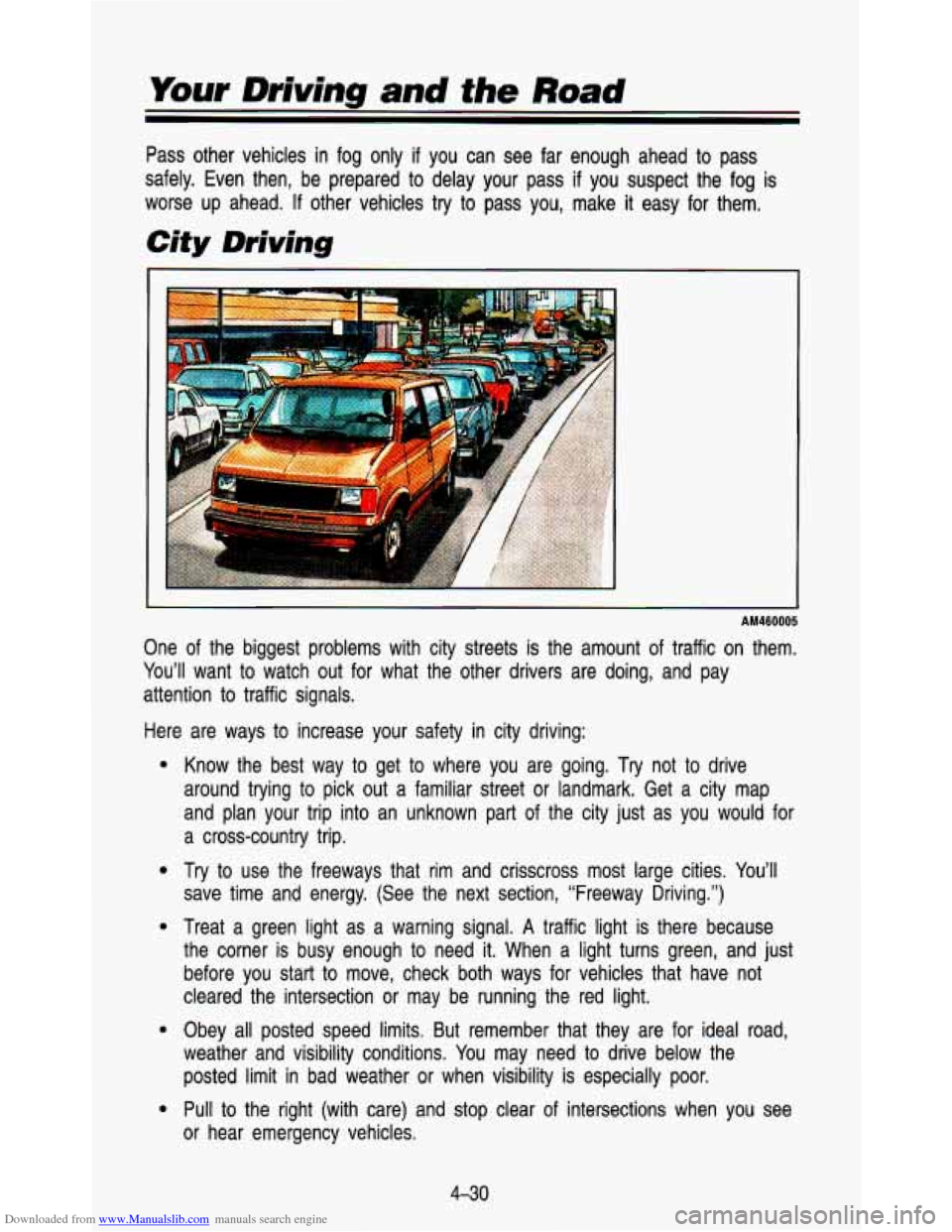
Downloaded from www.Manualslib.com manuals search engine Your Driving and the Road
Pass other vehicles in fog only if you can see far enough ahead to pass
safely. Even then, be prepared to delay your pass
if you suspect the fog is
worse up ahead.
If other vehicles try to pass you, make it easy for them.
City Driving
AM460005
One of the biggest problems with city streets is the amount of traffic on them.
You’ll want to watch out for what the other drivers are doing, and pay
attention to traffic signals.
Here are ways to increase your safety in city driving:
e
e
e
e
Know the best way to get to where you are going. Try not to drive
around trying to pick out a familiar street or landmark. Get \
a city map
and plan your trip into an unknown part of the city just as you would for
a cross-county trip.
Try to use the freeways that rim and crisscross most large cities. You’ll
save time and energy. (See the next section, “Freeway Drivi\
ng.”)
Treat a green light as a warning signal.
A traffic light is there because
the corner is busy enough to need
it. When a light turns green, and just
before you start to move, check both ways for vehicles that have not
cleared the intersection or may be running the red light.
Obey all posted speed limits. But remember that they are for ideal road,
weather and visibility conditions. You may need to drive below the
posted limit in bad weather
or when visibility is especially poor.
Pull to the right (with care) and stop clear of intersections when y\
ou see
or hear emergency vehicles.
430
Page 185 of 345
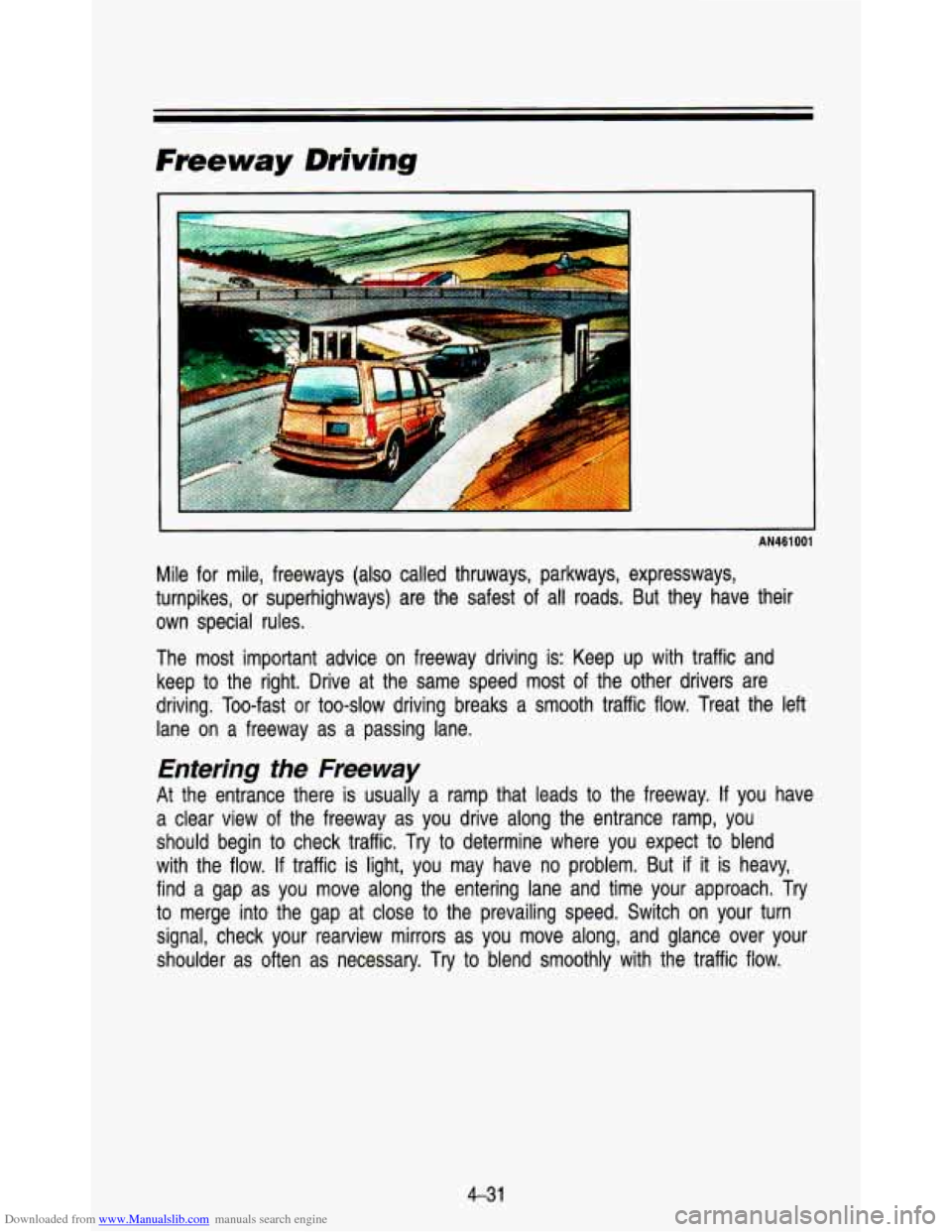
Downloaded from www.Manualslib.com manuals search engine Freeway Driving
I
P
AN461001
Mile for mile, freeways (also called thruways, parkways, expres\
sways,
turnpikes, or superhighways) are the safest of all roads. But they have their
own special rules.
The most important advice on freeway driving is: Keep up with \
traffic and
keep
to the right. Drive at the same speed most of the other drivers \
are
driving. Too-fast or too-slow driving breaks a smooth traffic
flow. Treat the left
lane on a freeway as a passing lane.
Entering the Freeway
At the entrance there is usually a ramp that leads to the freewa\
y. If you have
a clear view of the freeway as you drive along the entrance ramp, you
should begin to check traffic. Try to determine where you expect to blend
with the flow.
If traffic is light, you may have no problem. But if it is heavy,
find a gap as you move along the entering lane and time your\
approach. Try
to merge into the gap at close to the prevailing speed. Switc\
h on your turn
signal, check your rearview mirrors as you move along, and gla\
nce over your
shoulder as often as necessary.
Try to blend smoothly with the traffic flow.
4-31
Page 186 of 345
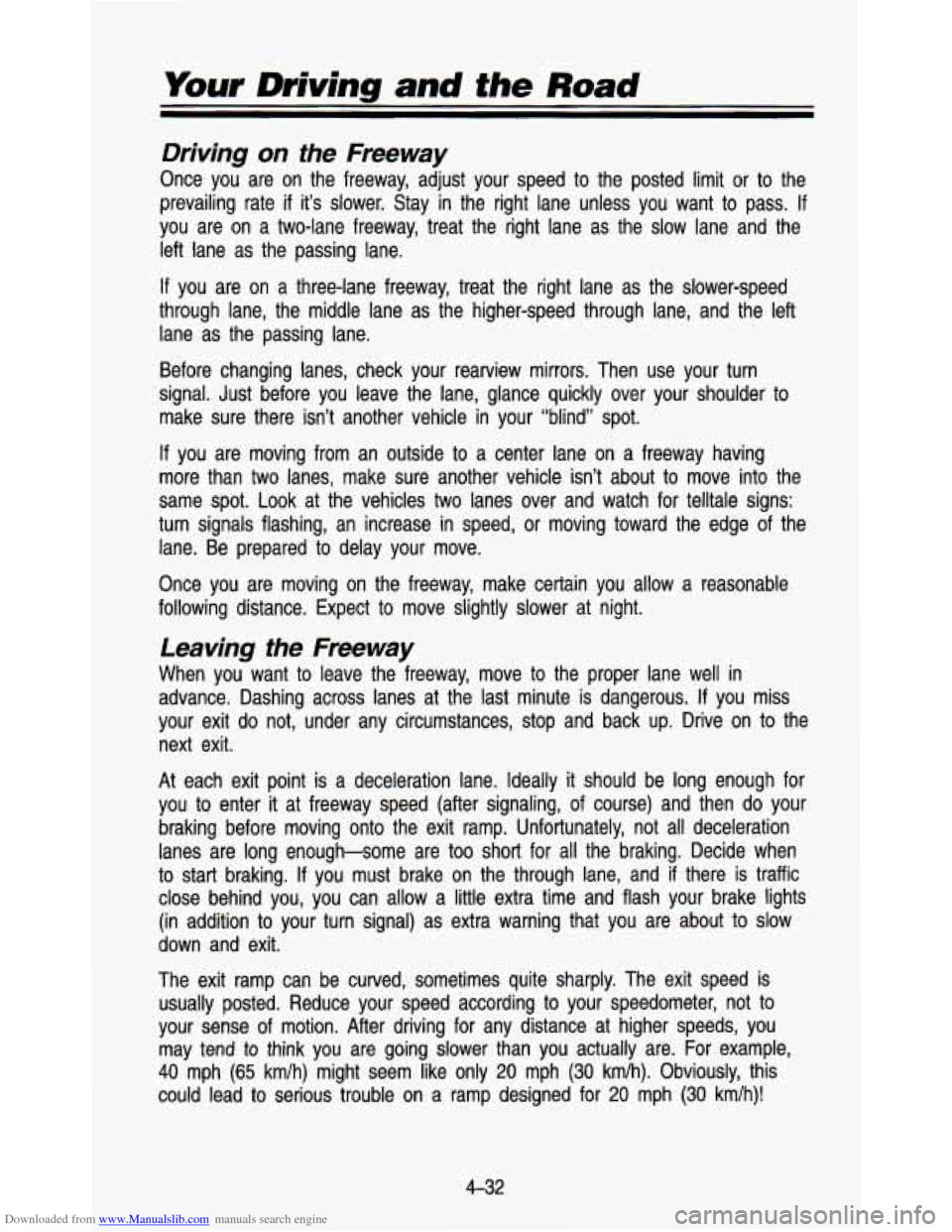
Downloaded from www.Manualslib.com manuals search engine Your Driving and the Road
Driving on the Freeway
Once you are on the freeway, adjust your speed to the posted \
limit or to the
prevailing rate
if it’s slower. Stay in the right lane unless you want to pass. If
you are on a two-lane freeway, treat the right lane as the s\
low lane and the
left lane as the passing lane.
If you are on a three-lane freeway, treat the right lane as the \
slower-speed
through lane, the middle lane as the higher-speed through lane,\
and the left lane as the passing lane.
Before changing lanes, check your rearview mirrors. Then use yo\
ur turn
signal. Just before you leave the lane, glance quickly over yo\
ur shoulder to make sure there isn’t another vehicle in your “blind” \
spot.
If you are moving from an outside to a center lane on a freeway\
having
more than two lanes, make sure another vehicle isn’t about \
to move into the
same spot. Look at the vehicles
two lanes over and watch for telltale signs:
turn signals flashing, an increase in speed, or moving toward \
the edge of the
lane. Be prepared to delay your move.
Once you are moving on the freeway, make certain you allow a \
reasonable
following distance. Expect to move slightly slower at night.
Leaving the Freeway
When you want to leave the freeway, move to the proper lane \
well in
advance. Dashing across lanes at the last minute is dangerous. \
If you miss
your exit do not, under any circumstances, stop and back up. \
Drive on to the
next exit.
At each exit point is a deceleration lane. Ideally
it should be long enough for
you to enter
it at freeway speed (after signaling, of course) and then do yo\
ur
braking before moving onto the exit ramp. Unfortunately, not al\
l deceleration
lanes are long enough-some are too short for all the braking. \
Decide when
to start braking.
If you must brake on the through lane, and if there is traffic
close behind you, you can allow a little extra time and flash\
your brake lights
(in addition to your turn signal) as extra warning that you \
are about
to slow
down and exit.
The exit ramp can be curved, sometimes quite sharply. The exit\
speed is usually posted. Reduce your speed according to your speedometer,\
not to
your sense of motion. After driving for any distance at higher\
speeds, you may tend
to think you are going slower than you actually are. For example,\
40 mph (65 km/h) might seem like only 20 mph (30 kmk). Obviously, this
could lead to serious trouble on
a ramp designed for 20 mph (30 kmlh)!
4-32